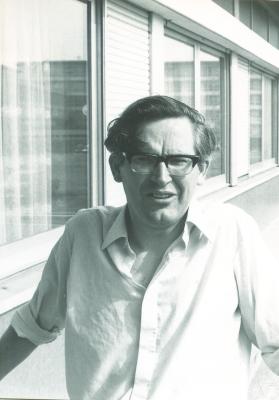David Williams (mathematician) facts for kids
Quick facts for kids
David Williams
|
|
|---|---|

Williams in 1975
|
|
| Born |
Gower Peninsula, Swansea, UK
|
| Alma mater | Jesus College, Oxford |
| Known for | Path decomposition of Brownian excursions |
| Scientific career | |
| Institutions | Stanford University University of Durham University of Cambridge University College of Swansea University of Bath |
| Thesis | Random time substitution in Markov chains (1962) |
| Doctoral advisor | D. G. Kendall and G. E. H. Reuter |
| Doctoral students | Martin Baxter Chris Rogers |
David Williams is a famous Welsh mathematician. He is known for his work in probability theory. This is a branch of mathematics that deals with how likely events are to happen.
Contents
Early Life and Learning
David Williams was born in a place called Gorseinon, near Swansea, Wales. He went to Gowerton Grammar School. He was very good at math and won a special scholarship. This allowed him to study at Jesus College, Oxford.
Later, he earned his DPhil, which is like a PhD. His main teachers were David George Kendall and Gerd Edzard Harry Reuter. For his final project, called a thesis, he wrote about "Random time substitution in Markov chains." This sounds complicated, but it's about how things change randomly over time.
His Amazing Career
David Williams has worked at many important universities. From 1962 to 1963, he was at Stanford University in the United States. After that, he worked at the University of Durham and the University of Cambridge.
In 1969, he moved to Swansea University. He became a top professor there in 1972. This meant he was recognized as a leading expert in his field.
In 1985, he became a professor at the University of Cambridge again. He led the Statistical Laboratory there from 1987 to 1991. This lab is a place where mathematicians study statistics. After Cambridge, he worked at the University of Bath.
Since 1999, he has been back at Swansea University. He continues his research there as a Research Professor.
What He Studied
Professor Williams's research looks at many interesting topics. These include Brownian motion, which describes how tiny particles move randomly. He also studies diffusions and Markov processes. These are all about understanding random changes and patterns over time. He also works with martingales, which are special sequences of random events.
Awards and Recognition
David Williams has received many honors for his work. In 1984, he was chosen to be a Fellow of the Royal Society. This is a very high honor for scientists in the UK. They recognized him for his work on how to build Markov chains. They also praised his discoveries about how Brownian motion paths can be broken down.
In 1994, he won the London Mathematical Society's Pólya Prize. This is another important award for mathematicians. One of his most important discoveries is how to understand Brownian paths. He found a way to break them down based on their highest point.
Books He Wrote
David Williams has written several important books. These books help other mathematicians learn about probability and random processes. Some of his well-known books include:
- Probability with Martingales
- Weighing the Odds
He also co-wrote two books with L. C. G. Rogers. These are called Diffusions, Markov Processes and Martingales.
His Books
- Diffusions, Markov processes, and martingales, Wiley 1979; 2nd. edn. with L. C. G. Rogers: Diffusions, Markov processes, and martingales, Volume One: Foundations, Wiley 1995; reprinting of 2nd edn. Cambridge University Press 2000
- with L. C. G. Rogers: Diffusions, Markov processes, and martingales, Volume Two: Itō calculus, Wiley 1988; 2nd edn. Cambridge University Press 2000
- Probability with martingales, Cambridge Mathematical Textbooks, Cambridge University Press 1991
- Weighing the Odds: a course in probability and statistics, Cambridge University Press 2001
- ed. with J. C. R. Hunt, O. M. Phillips: Turbulence and stochastic processes. Kolmogorov´s ideas 50 years on, London, Royal Society 1991

